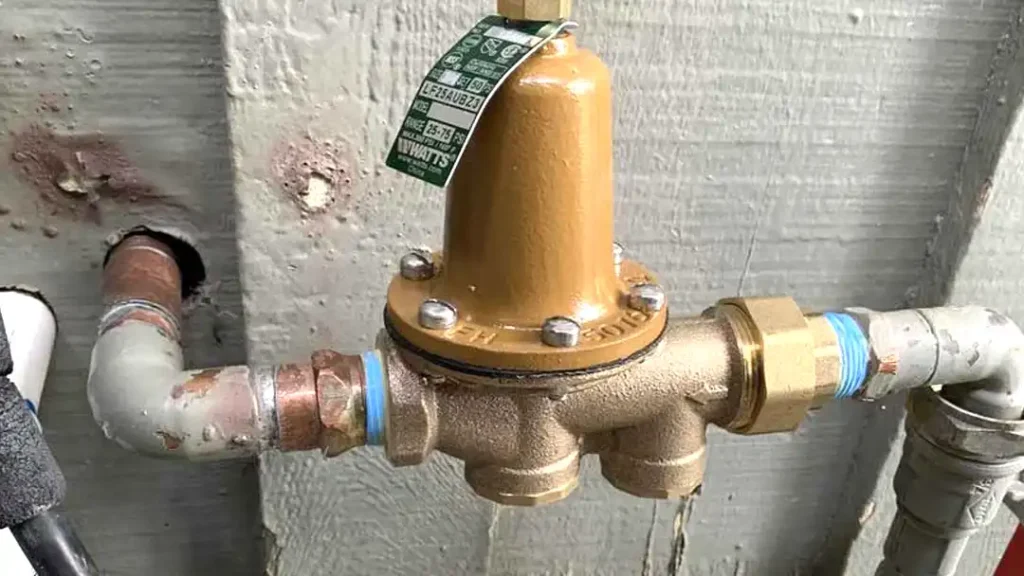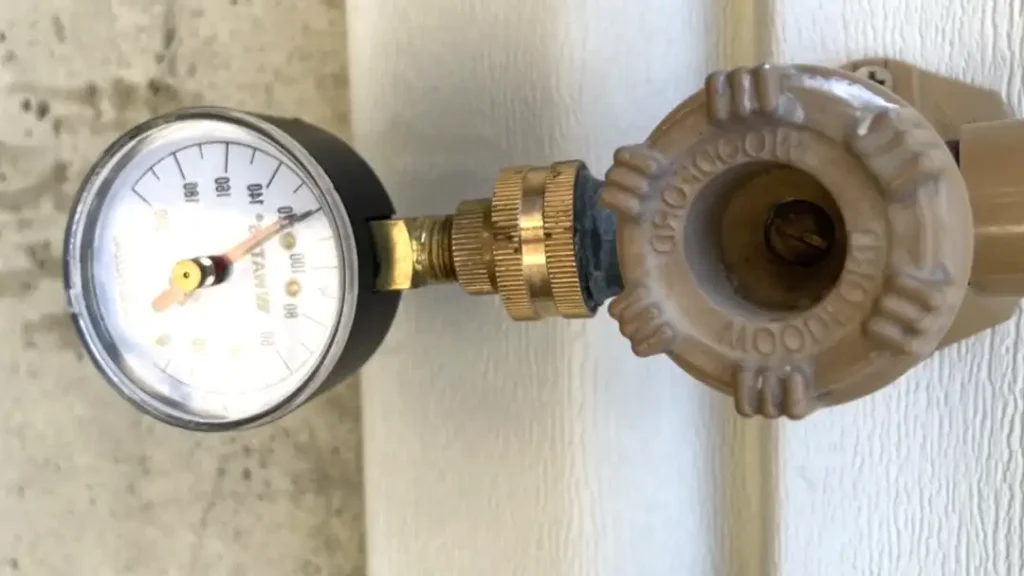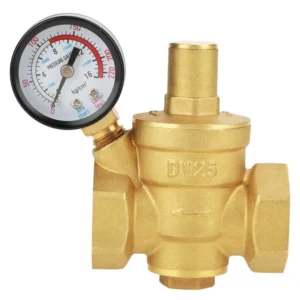Water pressure regulators play a crucial role in maintaining the efficiency and longevity of plumbing systems. These devices ensure that the water pressure entering a home or building is at a safe and manageable level.
Understanding how water pressure regulators work, their benefits, and how to maintain them can help prevent potential plumbing issues and extend the life of your plumbing system.
What is a Water Pressure Regulator?
A water pressure regulator is a valve that reduces the high pressure of water coming from the main water line into a lower, safer pressure before it enters your home’s plumbing system. This device is typically installed where the main water line enters the house.
What Does a Water Pressure Regulator Look Like
A water pressure regulator typically looks like a small cylindrical or box-shaped device connected to the main water supply line.
It usually has a dial or knob on the top for adjusting the water pressure and inlet and outlet connections on either side for attaching pipes. The regulator may also have a gauge or pressure indicator to display the current water pressure.
What Does a Water Pressure Regulator Do

A water pressure regulator serves a crucial role in maintaining the integrity and functionality of a plumbing system.
Here’s a deeper explanation:
- Controls Water Pressure: The primary function of a water pressure regulator is to control the pressure of water flowing through the pipes. Municipal water supplies often deliver water at high pressures, which can be detrimental to household plumbing fixtures, pipes, and appliances. The regulator reduces this pressure to a safe and manageable level.
- Prevents Damage: High water pressure can cause significant damage to plumbing components over time. It can lead to leaks, bursts, and premature wear and tear on pipes, valves, and fittings. By reducing the pressure, the regulator helps prevent these issues, saving homeowners from costly repairs and water damage.
- Protects Appliances: Household appliances such as water heaters, dishwashers, and washing machines are designed to operate within specific pressure ranges. Excessive water pressure can damage these appliances, leading to malfunctions and reduced lifespan. The regulator ensures that the water pressure remains within safe limits, protecting appliances and extending their usability.
- Ensures Consistent Flow: Fluctuating water pressure can result in inconsistent water flow at faucets and fixtures throughout the house. This can be frustrating and inconvenient for homeowners. The water pressure regulator maintains a steady and consistent flow of water, ensuring a reliable supply for various household activities like showering, dishwashing, and laundry.
- Improves Water Efficiency: By regulating the pressure, the regulator helps optimize water usage within the household. Excessive pressure can cause wasteful practices such as overfilling sinks and using more water than necessary for tasks like watering plants or washing dishes. By reducing pressure to an appropriate level, the regulator promotes water conservation and efficiency.
A water pressure regulator plays a vital role in promoting the longevity, efficiency, and reliability of a plumbing system, making it an essential component for residential and commercial properties alike.
Why is Water Pressure Regulation Important?

Water pressure regulation is a critical aspect of maintaining a healthy and efficient plumbing system. Without proper regulation, the water pressure in your home can cause a variety of issues, from minor inconveniences to major damage. Understanding why water pressure regulation is important can help you protect your home and ensure the longevity of your plumbing fixtures and appliances.
Prevents Damage to Plumbing and Appliances
One of the most significant reasons for regulating water pressure is to prevent damage to your plumbing system and household appliances. High water pressure can lead to:
- Burst Pipes: Excessive pressure can cause pipes to burst, leading to water damage and costly repairs.
- Leaking Fixtures: Faucets, showerheads, and other fixtures can develop leaks when subjected to high pressure over time.
- Appliance Damage: Water heaters, dishwashers, washing machines, and other appliances can wear out more quickly or malfunction under high pressure.
Enhances Appliance Efficiency and Longevity
Proper water pressure ensures that appliances operate efficiently and last longer. Appliances like dishwashers and washing machines are designed to work within a specific pressure range. When water pressure is too high or too low, these appliances may not function correctly, leading to:
- Reduced Efficiency: Appliances may use more water and energy than necessary.
- Increased Wear and Tear: Excessive pressure can strain components, leading to premature failure.
Conserves Water and Reduces Bills
Regulating water pressure helps in conserving water, which can lead to lower utility bills. High water pressure often results in:
- Increased Water Usage: More water flows through fixtures at high pressure, even if it’s not needed.
- Higher Energy Costs: Appliances may use more energy to heat and pump water at higher pressures.
Improves Comfort and Performance
Optimal water pressure enhances the comfort and performance of your plumbing system. This includes:
- Consistent Water Flow: Ensures a steady flow of water in showers, faucets, and other fixtures.
- Balanced System: Helps in maintaining balanced pressure throughout the home, preventing pressure fluctuations.
Protects Against Water Hammer
Water hammer is a phenomenon that occurs when water flow is suddenly stopped or changed, creating a shockwave that travels through the pipes. High water pressure can exacerbate this issue, leading to:
- Noisy Pipes: Loud banging or knocking sounds in the plumbing system.
- Pipe Damage: Over time, repeated water hammer can weaken pipes and joints.
Reduces Maintenance Needs
By maintaining proper water pressure, you can reduce the frequency and extent of maintenance needed for your plumbing system. This includes:
- Fewer Leaks and Drips: Lower pressure reduces the likelihood of leaks developing in fixtures and pipes.
- Less Wear on Components: Pipes, valves, and fixtures experience less stress, leading to fewer repairs and replacements.
Promotes Safety
Regulating water pressure also contributes to the overall safety of your home. High pressure can create dangerous situations, such as:
- Scalding Risk: High pressure can cause sudden temperature changes in water, increasing the risk of scalding.
- Structural Damage: Water leaks and bursts can lead to structural damage in your home, compromising safety.
Compliance with Building Codes
Many local building codes and regulations require homes to have water pressure regulators installed to maintain safe pressure levels. Compliance with these codes ensures that your plumbing system meets safety standards and can also impact home insurance policies.
Types of Water Pressure Regulators

Let’s delve deeper into the types of water pressure regulators:
Pressure Reducing Valves (PRVs)
Pressure reducing valves (PRVs) are the most commonly used type of water pressure regulators in residential settings. These valves are typically installed at the point where the main water line enters a building. PRVs work by automatically adjusting the incoming water pressure to a predetermined level, ensuring that it remains within a safe and manageable range.
How PRVs Work:
- Adjustable Spring Mechanism: PRVs contain an adjustable spring mechanism that controls the valve’s opening and closing. When the water pressure exceeds the set limit, the spring compresses, closing the valve partially to reduce the flow of water.
- Maintains Consistent Pressure: By regulating the flow of water, PRVs ensure that the pressure remains consistent throughout the plumbing system, preventing fluctuations that could lead to damage or inefficiency.
- Built-in Pressure Gauge: Many PRVs come with a built-in pressure gauge or indicator that allows homeowners to monitor the water pressure and make adjustments as needed.
Adjustable Water Pressure Regulators
Adjustable water pressure regulators offer homeowners more control over their plumbing systems by allowing them to manually adjust the water pressure to their desired level. These regulators are particularly useful in situations where the water pressure fluctuates frequently or where specific fixtures or appliances require different pressure settings.
Features of Adjustable Regulators:
- Manual Adjustment Knob: Adjustable regulators feature a manual adjustment knob or screw that allows users to increase or decrease the pressure as needed.
- Versatility: Homeowners can tailor the water pressure to suit their preferences or the requirements of different fixtures and appliances, such as showers, faucets, or washing machines.
- Ideal for Specific Applications: Adjustable regulators are commonly used in situations where precise pressure control is necessary, such as in irrigation systems or industrial applications.
Single-Stage vs. Dual-Stage Regulators
Water pressure regulators are further categorized into single-stage and dual-stage regulators based on their design and functionality.
Single-Stage Regulators:
Single-stage regulators reduce the water pressure in one step. They are typically used in residential applications where a single pressure setting is sufficient to meet the needs of the entire plumbing system.
Dual-Stage Regulators:
Dual-stage regulators provide more precise control over the water pressure by reducing it in two stages. These regulators are often used in more complex plumbing systems or in situations where the water pressure needs to be fine-tuned for specific applications or zones within a building.
Benefits of Dual-Stage Regulators:
- Improved Accuracy: Dual-stage regulators offer greater precision in maintaining the desired water pressure, resulting in more consistent performance and efficiency.
- Enhanced Flexibility: With dual-stage regulators, homeowners have the flexibility to adjust the pressure in multiple stages, allowing for finer control and customization.
- Suitable for Varied Applications: Dual-stage regulators are well-suited for applications where different pressure levels are required for different purposes, such as in commercial buildings or multi-story homes.
What Happens When a Water Pressure Regulator Goes Bad

When a water pressure regulator malfunctions or goes bad, several issues may arise:
- High Water Pressure: One common problem is a failure to regulate the water pressure effectively. This can result in excessively high water pressure throughout the plumbing system, potentially leading to leaks, burst pipes, and damage to fixtures and appliances.
- Low Water Pressure: Conversely, a faulty regulator may fail to maintain adequate water pressure, resulting in reduced water flow at faucets, showers, and other fixtures. Low water pressure can hinder daily activities like showering, dishwashing, and laundry.
- Water Hammer: A malfunctioning regulator can also contribute to water hammer, a phenomenon characterized by loud banging or knocking noises in the pipes when water flow is suddenly stopped or redirected. This can occur due to rapid changes in water pressure caused by a malfunctioning regulator.
- Inconsistent Water Pressure: The regulator may produce inconsistent water pressure, causing fluctuations in water flow at different fixtures throughout the building. Inconsistent pressure can be frustrating and inconvenient for occupants, affecting their ability to perform tasks efficiently.
- Premature Wear and Tear: If left unchecked, a malfunctioning water pressure regulator can lead to premature wear and tear on plumbing components, fixtures, and appliances. This can result in increased repair and maintenance costs over time.
- Water Waste: In some cases, a faulty regulator may contribute to water waste by allowing excessive pressure or causing leaks in the system. This can lead to higher water bills and environmental impact due to unnecessary water usage.
A malfunctioning water pressure regulator can have various negative consequences, ranging from inconvenience and inefficiency to potential damage and increased expenses. It’s essential to address any issues promptly by repairing or replacing the regulator to maintain a properly functioning plumbing system.
Symptoms and Signs of Water Pressure Issues
Common Symptoms of High Water Pressure
- Noisy Pipes: Banging, knocking, or vibrating sounds in the plumbing system, often referred to as water hammer, can indicate high water pressure.
- Leaking Fixtures: Persistent leaks or drips from faucets, showerheads, or other fixtures may be a sign of excessive water pressure causing wear and tear on seals and connections.
- Shortened Appliance Lifespan: Appliances such as water heaters, dishwashers, and washing machines may experience premature failure due to the stress of operating under high water pressure.
- Increased Water Bills: High water pressure can lead to increased water consumption, resulting in higher utility bills without any noticeable increase in usage.
- Difficulty Controlling Water Flow: Difficulty controlling the flow of water from faucets or showerheads, even when turned to the lowest setting, can indicate high water pressure.
Signs of Low Water Pressure
- Weak Shower Stream: Reduced water flow from showerheads, faucets, or other fixtures, resulting in a weak or inadequate stream of water.
- Slow-Filling Appliances: Appliances such as washing machines, dishwashers, or toilets taking longer than usual to fill with water due to insufficient water pressure.
- Intermittent Water Flow: Inconsistent water flow from faucets or showerheads, with water pressure fluctuating between adequate and insufficient levels.
- Air in Water Lines: Air sputtering or spurting from faucets or fixtures when turned on, indicating air pockets in the water lines due to low pressure.
- Difficulty Flushing Toilets: Toilets may have difficulty flushing or may require multiple flushes to clear waste due to inadequate water pressure.
Causes and Risk Factors
Biological Factors
- Aging Infrastructure: Older pipes and valves may not handle high pressure effectively.
- Pipe Corrosion: Corroded pipes can increase pressure due to narrowed passages.
Environmental Factors
- Elevation Changes: Homes on higher ground may experience lower water pressure.
- Municipal Water Supply Variations: Fluctuations in the city water supply can impact home water pressure.
Lifestyle Factors
- Increased Water Usage: More water-consuming appliances and fixtures can affect pressure.
- Improper Installation: Incorrectly installed plumbing can lead to pressure problems.
Diagnosis and Tests
Checking Water Pressure
- Pressure Gauge: Attach to an outdoor faucet to measure the current water pressure.
- Smart Home Sensors: Use sensors to monitor and alert on pressure changes.
Professional Inspection
Hiring a licensed plumber to inspect and test your system can identify and address underlying issues.
Treatment Options
Installing a Water Pressure Regulator
- DIY Installation: For those with plumbing experience, installing a regulator can be straightforward.
- Professional Installation: Ensures correct setup and avoids potential issues.
Regular Maintenance
- Inspect Regulators Annually: Check for wear and tear or adjustments needed.
- Clean Filters: Regularly clean filters in the regulator to prevent blockages.
Preventive Measures
Regular Checks
- Monitor Pressure Levels: Use gauges to keep an eye on water pressure.
- Inspect Plumbing: Regularly inspect pipes and fixtures for signs of wear or damage.
Upgrading Plumbing Systems
- Replace Old Pipes: Modern materials like PEX or copper are more resilient.
- Install Pressure-Reducing Valves: On main lines to manage incoming pressure.
Personal Stories or Case Studies
Homeowner Experiences
- John’s Story: How installing a pressure regulator saved John from costly repairs.
- Linda’s Tale: Linda’s experience with low water pressure and how a regulator improved her water flow.
Expert Insights
Quotes from Plumbers
- Jane Doe, Master Plumber: “A water pressure regulator is a small investment that can prevent major plumbing issues.”
- John Smith, Plumbing Specialist: “Regular maintenance of your pressure regulator ensures it functions optimally and extends your plumbing system’s life.”
Conclusion
Understanding and maintaining water pressure regulators is essential for any homeowner. These devices not only protect your plumbing system but also enhance the efficiency of your household appliances. Regular checks and professional inspections can prevent issues and ensure a steady, safe water pressure throughout your home.

